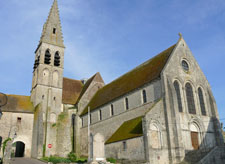Ferrières-en-Gâtinais (Loiret, France) - Saints-Pierre-et-Paul
- Disclaimer
The dating found here is based on the work of John James, and is meant on this site to serve as a starting point. James' dating is derived from a system that uses his interpretation of the development of capitals over time as the basis for chronology, among other factors. His goal is to refine the dating to within years rather than decades. I have not fully embraced James' methodology, and will be developing this page from its current state to one which is admittedly more conservative. The relative expenditure values found in the Timeline are also based on James' work, and I believe these to be reasonably reliable. They are intended only to give a sense of the amount of work involved in each decade.
I have added the idea of the "project" as a way of separating work in buildings. In my mind, a "project" is a discrete section of work in a building that resulted from the one-time acquisition of funding. "Projects" are generally separated by at least a decade where no work was being done. It is my view that it would have been unwise to start a "project" that could not be finished and protected from the elements, and as such a "project" usually involved a wing or multiple wings of a building, from floor to roof. Rural churches, which could only secure small amounts of funding at irregular intervals, often were the result of many small projects, while the great churches, which benefitted from relatively consistent funding, may have involved only a few large projects.
I have added the idea of the "project" as a way of separating work in buildings. In my mind, a "project" is a discrete section of work in a building that resulted from the one-time acquisition of funding. "Projects" are generally separated by at least a decade where no work was being done. It is my view that it would have been unwise to start a "project" that could not be finished and protected from the elements, and as such a "project" usually involved a wing or multiple wings of a building, from floor to roof. Rural churches, which could only secure small amounts of funding at irregular intervals, often were the result of many small projects, while the great churches, which benefitted from relatively consistent funding, may have involved only a few large projects.
- Timeline with Relative Expenditure (if available, in building units)
 |
 |
 |
 |
 |
 |
 |
 |
- Project A - 1130s - Phase 1 - apse
Two caps E1clerestory and remnants in walls of earlier apse,probably for barrel vault.
- Project B - 1150s - Phase 2 - nave (a)
West wall, north arcade aisles (6-8 caps as in Boigneville) and groin vaulted ES room
- Project B - 1160s - Phase 3 - n nave (c)
North nave clerestory
- Project B - 1160s - Phase 4 - w crossing
Entry into choir to capitals, square caps with unique impost with suggestion that intended an aisle into the octagon.
- Project C - 1180s - Phase 5 - octagon
Octagon drum bases and piers with imposts that seem misplaced, their shape suggests may have intended two arches to the east for a narrower apse.
- Project C - 1190s - Phase 6 - crossing walls
Complete surrounding walls to octagon, caps and groin arches, and octagon rib vaults probably at the same time.
- Project C - 1200s - Phase 7 - apse
Apse two straight bays with 6-part vault across wide span
- Project C - 1210s - Phase 8 - south
South transept
- Project C - 1220s - Phase 9 - north
North transept, arch cut through EN1
- Project D - Later - Phase 10 -
Apse, south nave wall
- Primary Sources for Dating
There are no primary source documents for this building
